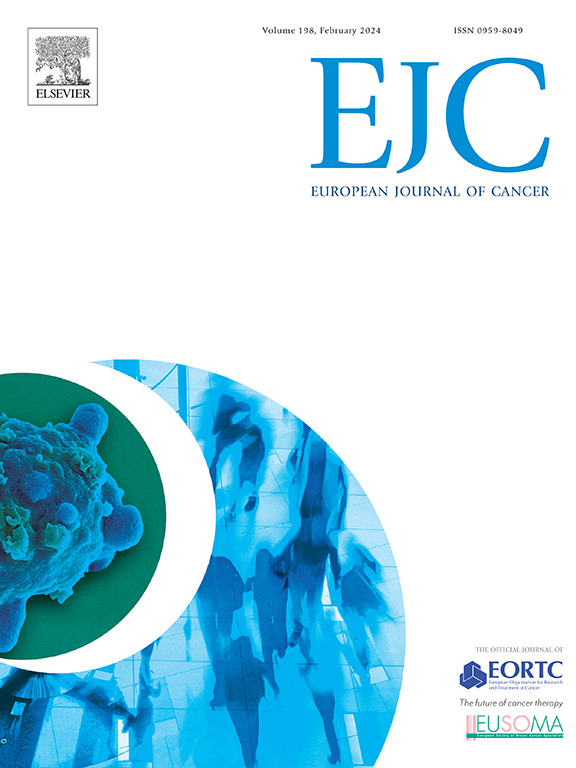Pathogenomic fingerprinting to identify associations between tumor morphology and epigenetic states
IF 7.6
1区 医学
Q1 ONCOLOGY
引用次数: 0
Abstract
Introduction
Measuring the chromatin state of a tumor provides a powerful map of its epigenetic commitments; however, as these are generally bulk measurements, it has not yet been possible to connect changes in chromatin accessibility to the pathological signatures of complex tumors. In parallel, recent advances in computational pathology have enabled the identification of spatial features and immune cells within oral cavity tumors and their microenvironment.
Methods
Here, we present pathogenomic fingerprinting (PaGeFin), a novel method that integrates morphological tumor features with chromatin states using ATAC-seq. This framework links spatial morphologic and epigenetic features, offering insights into tumor progression and immune evasion within and across tumors. Morphologic features describing spatial relationships between tumor and lymphocyte cells that are prognostic of oral cavity squamous cell carcinoma (OSCC) were identified through AI-driven pathology analysis. These pathomic features were spatially colocalized within the epigenome of 4 distinct sections of 4 OSCC tumors.
Results
These key features pinpointed chromatin regions responsible for critical immune cell function through peak locations and enrichment analysis, highlighting loci of CD27+ memory B cells, helper CD4+ T cells, and cytotoxic CD8 naïve T cells that likely drive morphologic changes in the distribution of lymphocytes in the tumor microenvironment and promote aggressive tumor behavior. Gene Ontology analysis revealed that the CTLA4, CD79A, CD3D, and CCR7 genes were embedded in these regions.
Conclusion
This computational approach is the first to assess the correlation between pathomic and epigenetic features in the context of cancer.
病理指纹鉴定肿瘤形态和表观遗传状态之间的关系
测量肿瘤的染色质状态提供了其表观遗传承诺的强大地图;然而,由于这些通常是大量测量,还不可能将染色质可及性的变化与复杂肿瘤的病理特征联系起来。与此同时,计算病理学的最新进展已经能够识别口腔肿瘤及其微环境中的空间特征和免疫细胞。方法在此,我们提出了一种利用ATAC-seq将肿瘤形态学特征与染色质状态相结合的新方法——病理指纹(PaGeFin)。该框架将空间形态学和表观遗传学特征联系起来,为肿瘤进展和肿瘤内部和肿瘤之间的免疫逃避提供了见解。描述肿瘤和淋巴细胞之间空间关系的形态学特征是口腔鳞状细胞癌(OSCC)的预后,通过人工智能驱动的病理分析确定。这些病理特征在空间上共定位于4个OSCC肿瘤的4个不同部分的表观基因组中。这些关键特征通过峰值定位和富集分析确定了负责关键免疫细胞功能的染色质区域,突出了CD27+记忆B细胞、辅助性CD4+ T细胞和细胞毒性CD8 naïve T细胞的位点,这些位点可能驱动肿瘤微环境中淋巴细胞分布的形态学变化,并促进肿瘤的侵袭性行为。基因本体分析显示CTLA4、CD79A、CD3D和CCR7基因嵌入在这些区域。结论该计算方法首次评估了癌症背景下病理和表观遗传特征之间的相关性。
本文章由计算机程序翻译,如有差异,请以英文原文为准。
求助全文
约1分钟内获得全文
求助全文
来源期刊

European Journal of Cancer
医学-肿瘤学
CiteScore
11.50
自引率
4.80%
发文量
953
审稿时长
23 days
期刊介绍:
The European Journal of Cancer (EJC) serves as a comprehensive platform integrating preclinical, digital, translational, and clinical research across the spectrum of cancer. From epidemiology, carcinogenesis, and biology to groundbreaking innovations in cancer treatment and patient care, the journal covers a wide array of topics. We publish original research, reviews, previews, editorial comments, and correspondence, fostering dialogue and advancement in the fight against cancer. Join us in our mission to drive progress and improve outcomes in cancer research and patient care.
 求助内容:
求助内容: 应助结果提醒方式:
应助结果提醒方式:


